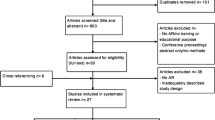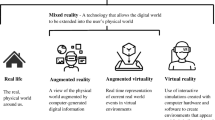Abstract
Minimally invasive surgery (MIS) is a widespread approach in general surgery. Computer guiding software, such as the augmented reality (AR), the virtual reality (VR) and mixed reality (MR), has been proposed to help surgeons during MIS. This study aims to report these technologies' current knowledge and diffusion during surgical training in Italy. A web-based survey was developed under the aegis of the Italian Society of Endoscopic Surgery (SICE). Two hundred and seventeen medical doctors’ answers were analyzed. Participants were surgeons (138, 63.6%) and residents in surgery (79, 36.4%). The mean knowledge of the role of the VR, AR and MR in surgery was 4.9 ± 2.4 (range 1–10). Most of the participants (122, 56.2%) did not have experience with any proposed technologies. However, although the lack of experience in this field, the answers about the functioning of the technologies were correct in most cases. Most of the participants answered that VR, AR and MR should be used more frequently for the teaching and training and during the clinical activity (170, 80.3%) and that such technologies would make a significant contribution, especially in training (183, 84.3%) and didactic (156, 71.9%). Finally, the main limitations to the diffusion of these technologies were the insufficient knowledge (182, 83.9%) and costs (175, 80.6%). Based on the present study, in Italy, the knowledge and dissemination of these technologies are still limited. Further studies are required to establish the usefulness of AR, VR and MR in surgical training.


Similar content being viewed by others
Availability of data and material
All raw data are available if required under direct request of the corresponding author of the article.
Code availability (software application or custom code)
Not applicable.
References
Nicolau S, Soler L, Mutter D, Marescaux J (2011) Augmented reality in laparoscopic surgical oncology. Surg Oncol. 20(3):189–201. https://doi.org/10.1016/j.suronc.2011.07.002
Coleman J, Nduka CC, Darzi A (1994) Virtual reality and laparoscopic surgery. Br J Surg. 81(12):1709–11. https://doi.org/10.1002/bjs.1800811204
Bernhardt S, Nicolau SA, Soler L, Doignon C (2017) The status of augmented reality in laparoscopic surgery as of 2016. Med Image Anal. 37:66–90. https://doi.org/10.1016/j.media.2017.01.007
Tang SL, Kwoh CK, Teo MY, Sing NW, Ling KV (1998) Augmented reality systems for medical applications. IEEE Eng Med Biol Mag May-Jun 17(3):49–58. https://doi.org/10.1109/51.677169
Marescaux J, Rubino F, Arenas M, Mutter D, Soler L (2004) Augmented-reality-assisted laparoscopic adrenalectomy. JAMA. 292(18):2214–5. https://doi.org/10.1001/jama.292.18.2214-c
Milgram P, Kishino AF (1994) Taxonomy of mixed reality visual displays. IEICE Trans Inform Syst E77-D:1321–1329
Sugimoto M, Yasuda H, Koda K, Suzuki M, Yamazaki M, Tezuka T, Kosugi C, Higuchi R, Watayo Y, Yagawa Y, Uemura S, Tsuchiya H, Azuma T (2010) Image overlay navigation by markerless surface registration in gastrointestinal, hepatobiliary and pancreatic surgery. J Hepatobiliary Pancreat Sci. 17(5):629–36. https://doi.org/10.1007/s00534-009-0199-y
Shuhaiber JH (2004) Augmented reality in surgery. Arch Surg. 139(2):170–4. https://doi.org/10.1001/archsurg.139.2.170
Volonté F, Pugin F, Bucher P, Sugimoto M, Ratib O, Morel P (2011) Augmented reality and image overlay navigation with OsiriX in laparoscopic and robotic surgery: not only a matter of fashion. J Hepatobiliary Pancreat Sci. 18(4):506–9. https://doi.org/10.1007/s00534-011-0385-6
Wang X, Zhang K, Hu W, Kuang M, Teo S, Guo Z, Zhao Q, He X (2021) A new platform for laparoscopic training: initial evaluation of the ex-vivo live multivisceral training device. Surg Endosc. 35(1):374–382. https://doi.org/10.1007/s00464-020-07411-z
Code of Conduct for responsible Research. World Health Organization (WHO) (2017) https://www.who.int/about/ethics/code-of-conduct-responsible-research.pdf.
Eysenbach G (2004) Improving the quality of Web surveys: the checklist for reporting results of internet E-surveys (CHERRIES). J Med Internet Res. 29;6(3):e34. https://doi.org/10.2196/jmir.6.3.e34. Erratum in: https://doi.org/10.2196/jmir.2042
Tang R, Ma L, Xiang C, Wang X, Li A, Liao H, Dong J (2017) Augmented reality navigation in open surgery for hilar cholangiocarcinoma resection with hemihepatectomy using video-based in situ three-dimensional anatomical modeling: A case report. Medicine (Baltimore). 96(37):e8083. https://doi.org/10.1097/MD.0000000000008083
Diana M, Soler L, Agnus V, D’Urso A, Vix M, Dallemagne B, Faucher V, Roy C, Mutter D, Marescaux J, Pessaux P (2017) Prospective evaluation of precision multimodal gallbladder surgery navigation: virtual reality, near-infrared fluorescence, and X-ray-based intraoperative cholangiography. Ann Surg. 266(5):890–897. https://doi.org/10.1097/SLA.0000000000002400
Alaker M, Wynn GR, Arulampalam T (2016) Virtual reality training in laparoscopic surgery: A systematic review & meta-analysis. Int J Surg. 29:85–94. https://doi.org/10.1016/j.ijsu.2016.03.034
Jin C, Dai L, Wang T (2021) The application of virtual reality in the training of laparoscopic surgery: A systematic review and meta-analysis. Int J Surg. 87:105859. https://doi.org/10.1016/j.ijsu.2020.11.022
Sampogna G, Pugliese R, Elli M, Vanzulli A, Forgione A (2017) Routine clinical application of virtual reality in abdominal surgery. Minim Invasive Ther Allied Technol. 26(3):135–143. https://doi.org/10.1080/13645706.2016.1275016
Acknowledgements
Collaborators to be indexed: ARMIS (Augmented Reality in Minimally Invasive Surgery) Collaborative Group*.
*ARMIS Collaborative Group: Antonino Agrusa, Daniele Aguzzi, Mariantonietta Alagia, Laura Alberici, Marco Ettore Allaix, Luisa Ambrosio, Alfonso Amendola, Michele Ammendola, Pietro Maria Amodio, Gabriele Anania, Jacopo Andreuccetti, Alfredo Annichiarico, Pietro Anoldo, Alessandro Anselmo, Giovanni Aprea, Giacomo Arcuri, Alberto Arezzo, Giulia Armatura, Giulia Bagaglini, Francesco Bagolini, Beatrice Bailetti, Gianluca Baiocchi, Edoardo Baldini, Elisa Bannone, Mirko Barone, Gianluca Baronio, Raffaele Basile, Marco Bellucci, Andrea Benedetti Cacciaguerra, Ilaria Benzoni, Francesco Bianco, Giuseppe Boccia, Cristina Bombardini, Luigi Boni, Dario Bono, Luca Domenico Bonomo, Giulia Bonventre, Andrea Bottari, Claudio Botti, Giacomo Brentegani, Mattia Buonomo, Umberto Bracale, Cosimo Callari, Luca Calligaris, Pietro Giorgio Calò, Angelo Cangiano, Lorenzo Capezzuoli, Gabriella Teresa Capolupo, Marianna Capuano, Filippo Carannante, Eugenia Cardamone, Teresa Carfora, Chiara Caricato, Pietro Carnevali, Francesco Maria Carrano, Lorenzo Casali, Gianmaria Casoni Pataccini, Gianluca Cassese, Simone Castiglioni, Flavia Cavicchi, Graziano Ceccarelli, Giovanni Cestaro, Pasquale Cianci, Claudio Cimmino, Marco Clementi, Diego Coletta, Riccardo Conventi, Diletta Corallino, Maurizio Costantini, Lorenzo Crepaz, Diego Cuccurullo, Fabio Pio Curci, Giuseppe Currò, Giorgio Dalmonte, Giovanni D'Alterio, Michele D'Ambra, Giancarlo D’Ambrosio, Anna D’Amore, Michele De Capua, Simona Deidda, Daniele Delogu, Maurizio De Luca, Nicolò De Manzini, Elena De Stefani, Giuseppe Di Buono, Marcello Di Martino, Anna Di Tomaso, Ugo Elmore, Ingrid Elva Cordova Herencia, Giovanni Emiliani, Sofia Esposito, Federico Fazio, Federico Festa, Marcello Filotico, Fausto Fiocca, Irene Fiume, Francesco Fleres, Giulia Fontana, Tommaso Fontana, Edoardo Forcignanò, Giampaolo Formisano, Laura Fortuna, Uberto Fumagalli Romario, Andrea Galderisi, Raffaele Galleano, Carlo Gazia, Alessio Giordano, Giorgio Giraudo, Maria Carmela Giuffrida, Simona Giura, Anna Guida, Antonio Maria Iannello, Marco Inama, Sara Ingallinella, Angelo Iossa, Livio Iudici, Giovanni Guglielmo Laracca, Zoe Larghi Laureiro, Saverio Latteri, Luca Leonardi, Pasquale Lepiane, Edelweiss Licitra, Paolo Locurto, Sarah Lo Faso, Nicola Luciani, Luigi Luzza, Sara Magaletti, Michele Manigrasso, Alessandra Marano, Francesco Marchetti, Alessandra Marello, Nicolò Mariani, Jacopo Nicolò Marin, Gennaro Martines, Laura Mastrangelo, Antonio Matarangolo, Marco Materazzo, Gennaro Mazzarella, Giorgio Mazzarolo, Maria Paola Menna, Francesca Meoli, Marco Milone, Elisabetta Moggia, Davide Moioli, Sarah Molfino, Vitantonio Mongelli, Roberto Montalti, Giulia Montori, Luca Morelli, Gianluigi Moretto, Edoardo Maria Muttillo, Irnerio Muttillo, Francesca Notte, Alessandro M. Paganini, Gianluca Pagano, Livia Palmieri, Giuseppe Palomba, Valentina Palumbo, Cristina Panetta, Giulia Paradiso, Beniamino Pascotto, Daniele Passannanti, Renato Patrone, Francesca Pecchini, Francesca Pego, Fabio Pelle, Nicola Perrotta, Wanda Petz, Biagio Picardi, Andrea Picchetto, Chiara Piceni, Giulia Pietricola, Enrico Pinotti, Felice Pirozzi, Paolo Pizzini, Gaetano Poillucci, Ilaria Puccica, Lorenzo Ramaci, Eleonora Rapanotti, Daniela Rega, Angelica Reggiani, Giorgio Romano, Gregorio Romeo, Luigi Romeo, Gianluca Rompianesi, Stefano Rossi, Edoardo Saladino, Roberto Santambrogio, Federica Saraceno, Giuliano Sarro, Diego Sasia, Grazia Savino, Rosa Scaramuzzo, Antonio Sciuto, Michela Scollica, Giovanni Scudo, Ardit Seitaj, Carlo Serra, Francesco Serra, Pierpaolo Sileri, Leandro Siragusa, Carmen Sorrentino, Giuseppe Surfaro, Ernesto Tartaglia, Beatrice Torre, Andrea Tufo, Matteo Uccelli, Alessandro Ussia, Samuele Vaccari, Marina Valente, Sara Vertaldi, Alessandro Vitali, Luca Zaccherini, Luigi Zorcolo, Noemi Zorzetti.
Funding
The authors received no financial support for the research, authorship, and/or publication of this article.
Author information
Authors and Affiliations
Consortia
Contributions
AB, AS, EB, MP, MO, GS, MG and FA did study conception and design, acquisition of data, analysis, and interpretation of data, drafting of manuscript, critical revision of manuscript, and final approval.
Corresponding author
Ethics declarations
Conflict of interest
The authors declare that they have no conflict of interest.
Ethics approval
All procedures performed in this study involving human participants were in accordance with the ethical standards of the institutional and/or national research committee and with the 1964 Helsinki Declaration and its later amendments or comparable ethical standards. A formal approval by the Ethics Committee is not required for survey studies in Italy.
Consent to participate
Informed consent from all participants was obtained.
Consent for publication
All authors approved the publication of the manuscript in the Journal.
Additional information
Publisher's Note
Springer Nature remains neutral with regard to jurisdictional claims in published maps and institutional affiliations.
Supplementary Information
Below is the link to the electronic supplementary material.
Rights and permissions
Springer Nature or its licensor holds exclusive rights to this article under a publishing agreement with the author(s) or other rightsholder(s); author self-archiving of the accepted manuscript version of this article is solely governed by the terms of such publishing agreement and applicable law.
About this article
Cite this article
Balla, A., Sartori, A., Botteri, E. et al. Augmented reality (AR) in minimally invasive surgery (MIS) training: where are we now in Italy? The Italian Society of Endoscopic Surgery (SICE) ARMIS survey. Updates Surg 75, 85–93 (2023). https://doi.org/10.1007/s13304-022-01383-6
Received:
Accepted:
Published:
Issue Date:
DOI: https://doi.org/10.1007/s13304-022-01383-6




